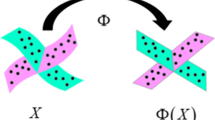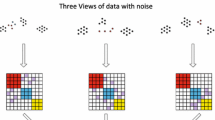Abstract
During the past years, multi-view clustering algorithms have demonstrated satisfactory clustering results by fusing the multiple views of the dataset. Nowadays, the researches of dimensionality reduction and learning discriminative features from multi-view data have soared in the literatures. As for clustering, generating the suitable subspace of the high dimensional multi-view data is crucial to boost the clustering performance. In addition, the relationship between the original data and the clusters still remains uncovered. In this article, we design a new multi-view low rank sparse representation method based on three-way clustering to tackle these challenges, which derive the common consensus low dimensional representation from the multi-view data and further proceed to get the relationship between the data items and clusters. Specifically, we accomplish this goal by taking advantage of the low-rank and the sparse factor on the data representation matrix. The \(L_{2,1}\) norm is imposed on error matrix to reduce the impact of noise contained in the data. Finally, a new objective function is constructed to preserve the consistency between the views by using the low-rank sparse representation technique. The weighted low-rank matrix is utilized to build the consensus low rank matrix. Then, the whole objective function is optimized by using the Augmented Lagrange’s Multiplier algorithm. Further, to find the uncertain relationship between the data items and the clusters, we pursue the neighborhood based three-way clustering technique to reflect the data items into core and fringe regions. Experiments conducted on the real-world datasets show the superior performance of the proposed method compared with the state-of-the-art algorithms.












Similar content being viewed by others
Notes
References
Yang Y, Wang H (2018) Multi-view clustering: a survey. Big Data Min Anal 1(2):83–107
Ye W, Wang H, Yan S, Li T, Yang Y (2019) Nonnegative matrix factorization for clustering ensemble based on dark knowledge. Knowl-Based Syst 163:624–631
Zhao J, Xie X, Xu X, Sun S (2017) Multi-view learning overview: recent progress and new challenges. Inform Fusion 38:43–54
Mitra S, Hasanuzzaman M, Saha S (2020) A unified multi-view clustering algorithm using multi-objective optimization coupled with generative model. ACM Trans Knowl Discov Data (TKDD) 14(1):1–31
Peng X, Huang Z, Lv J, Zhu H, Zhou JT (2019) Comic: Multi-view clustering without parameter selection. In: Proc. of 36th international conference on machine learning, ICML, pp 5092–5101
Huang S, Kang Z, Xu Z (2018) Self-weighted multi-view clustering with soft capped norm. Knowl-Based Syst 158:1–8
Chen MS, Huang L, Wang CD, Huang D (2020) Multi-view clustering in latent embedding space. In: Proc. of 34th AAAI conference on artificial intelligence, AAAI, vol 34, no 4, pp 3513–3520
Kumar A, Daumé H (2011) A co-training approach for multi-view spectral clustering. In: Proc. of 28th international conference on machine learning, ICML, pp 393–400
Tao H, Hou C, Liu X, Liu T, Yi D, Zhu J (2018) Reliable multi-view clustering. In: Proc. of 32nd AAAI conference on artificial intelligence, AAAI, vol 32, no 1, pp 4123–4130
de Morsier F, Borgeaud M, Gass V, Thiran J-P, Tuia D (2016) Kernel low-rank and sparse graph for unsupervised and semi-supervised classification of hyperspectral images. IEEE Trans Geosci Remote Sens 54:3410–3420
Yu H, Zhang H (2016) A three-way decision clustering approach for high dimensional data. In: Proc. of international joint conference on rough sets, IJCRS, pp 229–239
Hu Z, Nie F, Tian L, Wang R, Li X (2018) A comprehensive survey for low rank regularization. arXiv:1808.04521
Elhamifar E, Vidal R (2013) Sparse subspace clustering: algorithm, theory, and applications. IEEE Trans Pattern Anal Mach Intell 35(11):2765–2781
Parsons L, Haque E, Liu H (2004) Subspace clustering for high dimensional data: a review. ACM SIGKDD Explor Newslett 6(1):90–105
Wang Y, Zhang W, Wu L, Lin X, Fang M, Pan S (2016) Iterative views agreement: an iterative low-rank based structured optimization method to multi-view spectral clustering. In: Proc. of 25th International Joint Conference on Artificial Intelligence, IJCAI, pp 2153–2159
Ding Z, Fu Y (2014) Low-rank common subspace for multi-view learning. In: Proc. of 14th IEEE international conference on data mining, ICDM, pp 110–119
Wang Y, Wu L, Lin X, Gao J (2018) Multiview spectral clustering via structured low-rank matrix factorization. IEEE Trans Neural Netw Learn Syst 29:4833–4843
Brbic M, Kopriva I (2018) Multi-view low-rank sparse subspace clustering. Pattern Recogn 73:247–258
Zhao Y, Dou Y, Liu X, Li T (2016) A novel multi-view clustering method via low-rank and matrix-induced regularization. Neurocomputing 216:342–350
Yu H, Wang X, Wang G, Zeng X (2020) An active three-way clustering method via low-rank matrices for multi-view data. Inform Sci 507:823–839
Liu G, Lin Z, Yan S, Sun J, Yu Y, Ma Y (2013) Robust recovery of subspace structures by low-rank representation. IEEE Trans Pattern Anal Mach Intell 35:171–184
Huang S, Kang Z, Tsang IW, Xu Z (2019) Auto-weighted multi-view clustering via kernelized graph learning. Pattern Recogn 88:174–184
Brbic M, Kopriva I (2020) \({l_0}\)-motivated low-rank sparse subspace clustering. IEEE Trans Cybern 50:1711–1725
Ding Z, Fu Y (2016) Robust multi-view subspace learning through dual low-rank decompositions. In: Proc. of 30th AAAI conference on artificial intelligence, AAAI, vol 30, no 1, pp 1181–1187
Xia R, Pan Y, Du L, Yin J (2014) Robust multi-view spectral clustering via low-rank and sparse decomposition. In: Proc. of 28th AAAI conference on artificial intelligence, AAAI, vol 28, no 1, pp 2149–2155
Zhan K, Niu C, Chen C, Nie F, Zhang C (2018) Graph structure fusion for multi-view clustering. IEEE Trans Knowl Data Eng 31(10):1984–1993
Zhan K, Zhang C, Guan J, Nie F, Wang J (2017) Graph learning for multi-view clustering. IEEE Trans Cybern 48(10):2887–2895
Zhan K, Nie F, Wang J, Yang Y (2018) Multiview consensus graph clustering. IEEE Trans Image Process 28(3):1261–1270
Jun W, Zhouchen L, Daming S, Dansong C, Yongqiang Z, Junbin G (2016) LRSR: low-rank-sparse representation for subspace clustering. Neurocomputing 214:1026–1037
Xiujun Z, Chen X, Xiaoli S, George B (2016) Schatten-\(q\) regularizer constrained low rank subspace clustering model. Neurocomputing 182:36–47
Qian Y, Yin X, Kong J, Wang J, Gao W (2019) Low-rank graph optimization for multi-view dimensionality reduction. PLoS One 14(12):2765–2781
Hong T, Chenping H, Yuhua Q, Jubo Z, Dongyun Y (2020) Latent complete row space recovery for multi-view subspace clustering. IEEE Trans Image Process 29(11):8083–8096
Miaomiao C, Liping J, Michael KN (2018) Tensor-based low-dimensional representation learning for multi-view clustering. IEEE Trans Image Process 28(5):2399–2414
Yu H, Chang Z, Wang G, Chen X (2020) An efficient three-way clustering algorithm based on gravitational search. Int J Mach Learn Cybern 11(5):1003–1016
Chengming Z, Lin M, Panhong W, Duoqian M (2020) Multi-view and multi-label method with three-way decision-based clustering. In: Proc. of 3rd Chinese conference on pattern recognition and computer vision, PRCV, pp 69–80
Yao Y (2012) An outline of a theory of three-way decisions. In: Proc. of 8th international conference on rough sets and current trends in computing, RSCTC, pp 1–17
Wang P, Shi H, Yang X, Mi J-S (2019) Three-way \(k\)-means: integrating \(k\)-means and three-way decision. Int J Mach Learn Cybern 10:1–11
Wang P, Yao Y (2018) Ce3: a three-way clustering method based on mathematical morphology. Knowl-Based Syst 155:54–65
Yao Y (2016) Three-way decisions and cognitive computing. Cogn Comput 8:543–554
Yu H, Wang X, Wang G (2017) A semi-supervised three-way clustering framework for multi-view data. In: Proc. of international joint conference on rough sets, IJCRS, pp 313–325
Yu H (2017) A framework of three-way cluster analysis. In: Proc. of international joint conference on rough sets, IJCRS, pp 300–312
Shi H, Liu Q, Wang P (2018) Three-way spectral clustering. In: Proc. of 24th international symposium on methodologies for intelligent systems, ISMIS, pp 389–398
Yang L, Hou K (2018) A method of incomplete data three-way clustering based on density peaks. In: Proc. of American Institute of Physics conference series, AIP, vol 1967, no 1, p 020008
Yang M-S, Sinaga KP (2019) A feature-reduction multi-view \(k\)-means clustering algorithm. IEEE Access 7(114):472 (114–486)
Khan GA, Hu J, Li T, Diallo B, Wang H (2021) Multi-view data clustering via non-negative matrix factorization with manifold regularization. Int J Mach Learn Cybern 1–13
Ye F, Chen Z, Qian H, Li R, Chen C, Zheng Z (2018) New approaches in multi-view clustering. In: Recent applications in data clustering, p 195
Wen J, Fang X, Xu Y, Tian C, Fei L (2018) Low-rank representation with adaptive graph regularization. Neural Netw 108:83–96
Elhamifar E, Vidal R (2009) Sparse subspace clustering. In: 2009 IEEE conference on computer vision and pattern recognition, CVPR, pp 2790–2797
Shen Y, Wen Z, Zhang Y (2014) Augmented Lagrangian alternating direction method for matrix separation based on low-rank factorization. Optim Methods Softw 29:239–263
Cai J-F, Candès EJ, Shen Z (2010) A singular value thresholding algorithm for matrix completion. SIAM J Optim 20(4):1956–1982
Ng AY, Jordan MI, Weiss Y (2002) On spectral clustering: analysis and an algorithm. In: NIPS’01: Proc. of the 14th international conference on neural information processing systems: natural and synthetic, vol 14, pp 849–856
Kumar A, Rai P, Daume H (2011) Co-regularized multi-view spectral clustering. In: NIPS’11: Proc. of the 24th international conference on neural information processing systems, vol 24, pp 1413–1421
Liu J, Wang C, Gao J, Han J (2013) Multi-view clustering via joint nonnegative matrix factorization. In: Proc. of 13th SIAM international conference on data mining, SMD, pp 252–260
Tzortzis G, Likas A (2012) Kernel-based weighted multi-view clustering. In: Proc. of 12th international conference on data mining, ICDM, pp 675–684
Jianlong W, Lin Z, Zha H (2019) Essential tensor learning for multi-view spectral clustering. IEEE Trans Image Process 28(12):5910–5922
Zhang C, Fu H, Liu S, Cao G (2015) Low-rank tensor constrained multiview subspace clustering. In: Proc. of 15th international conference on computer vision, ICCV, pp 1582–1590
Zhang C, hu Q, Fu H, Zhu P, Cao X (2017) Latent multi-view subspace clustering. In: Proc. of IEEE conference on computer vision and pattern recognition, CVPR, pp 4279–4287
Zhao K, Xinjia Z, Chong P, Hongyuan Z, Tianyi ZJ, Xi P, Wenyu C, Zenglin X (2020) A partition level multi-view subspace clustering. Neural Netw 122:279–288
Zhao K, Wangtao Z, Zhitong Z, Junming S, Meng H, Zenglin X (2020) Large-scale multi-view subspace clustering in linear time. In: Proc. of 34th AAAI conference on artificial intelligence, AAAI, vol 34, no 4, pp 4412–4419
Maaten LVD, Hinton G (2008) Visualizing data using t-SNE. J Mach Learn Res 9:2579–2605
Acknowledgements
This work is supported by the National Science Foundation of China (Nos. 61772435, 61976182, 61876157) and Sichuan Key R&D project (Nos. 2020YFG0035, 2021YFG0312).
Author information
Authors and Affiliations
Corresponding author
Additional information
Publisher's Note
Springer Nature remains neutral with regard to jurisdictional claims in published maps and institutional affiliations.
Rights and permissions
About this article
Cite this article
Khan, G.A., Hu, J., Li, T. et al. Multi-view low rank sparse representation method for three-way clustering. Int. J. Mach. Learn. & Cyber. 13, 233–253 (2022). https://doi.org/10.1007/s13042-021-01394-6
Received:
Accepted:
Published:
Issue Date:
DOI: https://doi.org/10.1007/s13042-021-01394-6




